
The ketch rigged Pilothouse version of the 44' CSY hull was a design ahead of it's time. Very traditional look overall, resembling European wooden designs of years gone past yet, like the Walk Over design already offered at CSY, the Pilothouse used all the best of the mid 70's technology, in a heavily built fiberglass modern hull. The architect, Peter Schmidt, obviously translated some of his Dutch old world heritage into the layout
 and design. At first glance, it was easy for one to say, "I want to charter that, or I want to own that."
and design. At first glance, it was easy for one to say, "I want to charter that, or I want to own that."One hull design platform for all CSY 44 models simplified production, yet with the eventual 4 different interior and deck mold options, the market was easily satisfied.
The Pilothouse was the 2nd of 4 final designs, the Walk Over (WO)being the 1st, the Walk Through(WT) and Bottomliner(commercial fishing version) were 3rd and 4th.
Click Photos to Enlarge.
The first Pilothouse actually had its interior finished at sea, on the way to the New York City Boat Show, in January 1978. The hull of #1 was dated Dec. 1977, and was the 4'11" shoal draft. CFO of CSY at the time was Martin Dean and he wanted it for his personal vessel after the boat show. He told me he and his wife wanted to cruise local West Florida waters, so the shoal draft was more appropriate for him. Like all 44's, there were two (2) draft options: 4'11" for shallow water access or 6'6" for sailing performance.

Cover of Maptech's 1980 East Coast Chart Pack
The Pilothouse, sailing to NY with the cutter right behind and off in the backround, actually graced the cover of the East Coast Chart Pack in 1980. The photo shows Frank Hamlin at the helm pressing on to NY.
The show was a success for CSY and the crowds at the "Colosseum" on NY's, 59th St. and Columbus Circle lined up for viewing. My boat, Pilothouse Hull #2 was sold to a doctor across the river in Perth Amboy, NJ from this show. Another, yet to be built Hull #3, had a contract written up for a pilothouse for an attorney out in Washington State. He actually called his friend Tom Foster from the show, to suggest strongly that he buy one too. Tom waited a month to see show printed material and the delay caused his hull # to go from 4, to #8! Yes, CSY's sold well at the show and the Pilothouse design was off and running! Naval architect Frank Hamlin was one of the N.A.'s at CSY and at this time. About this time, Peter Schmidt signed on full time. Frank Hamlin was then in charge of the Pilothouse project. It seems that many of the Pilothouse's built were kept private and did not enter the CSY Charter Fleet.

We move well in Light or Heavy air and surprise the common bragards out there. The PH performance can shut 'em up quickly!
CSY had not wanted to build a Walk Through model originally and spoke much to this point in early CSY brochures and literature. It opted for the Pilothouse configuration instead, to derive ultimate live-a-board qualities. As Queen of the fleet, she was priced well above the Center cockpit WO version. The company was aware of the extra cost to build this model. It seems only 22 of this Pilothouse version might have been built but at this point there is still uncertainty as to what happened to 5 or 6 of the slated hull numbers in the teens. We can find numbers but not the boats themselves. Possibly a plan to put a short production run, with numbers put aside, for a charter fleet that never materialized, but that's only a guess at this point.

Even dockside, they stand out; kinda like a Muscle Car does- parked but Ready!
Why build a pilothouse version? Well, CSY's competition for the charter trade were offering walk through designs.
Click any photo to Enlarge It.

There are obvious benefits to a Walk Through in general but CSY initially saw negatives. CSY went beyond just interior access issues with the pilothouse design tried to omit the negatives they felt were limiting in the center cockpit WT design. The Pilothouse model used the same hull as their standard 44' Walk Over, but the design allowed full access in the living quarters without ever needing to cross the cockpit of the WO. If you wanted a cup of coffee or a beer, you need not go outside from the aft cockpit to get it. If you were in the saloon and wanted to check a chart, back in the aft cabin's navigation station, you need not go out in the rain/sun to do so. If you were butt ass naked, you could enjoy your home afloat in private.......No showing off to the anchorage required! ;) So, now uninterrupted interior access was available in a CSY.
-Tankage was improved with a 5 tank layout/options for 6. Total tankage was 5-600 gallons (options for more)and apparently plumbed during construction to fill the needs of the new owner's demands for fuel and water. My boat has 3 fuel tanks totaling 325 gallons and 2 water tanks totaling 250 gallons. Others PH's differ somewhat.
-Ketch Rig/with main mast moved 4' forward of the cutter configuration. This offered easy safe smaller sail areas for each sail, but the design actually increased overall Total sail area to 950 sq.ft.(early drawing show this at 937-but was corrected in later printings). The ketch rig offers the ability to sail with mizzen and head sail for an easy to work sail plan in heavier weather, but there was the additional complexity and cost of the extra mast and rigging. More info on Ketch/mizzen benefits here:
-Main Mast height was increased from 54' and 56' on the W.O.'s to 58'9" on the Pilot House versions! More stick, but simple single spreader rig.
Early tank testing and literature from CSY stressed the ability of these early configurations to keep full sail plans to 30 knots. This is unheard of on most sailboats and was not valid on the tall double spreader rigs CSY later installed on WT's and a few WO's. Added height and shortened boom of the P.H. gave a more efficient/powerful mainsail (higher aspect ratio). The ketch sail area added about 50 sq. ft. to the W.O.'s sail plan. Foredeck was clear space as now there was no club footed boom on a stays'l. A thousand pounds of additional ballast was added for compensation to the Pilothouse keel encapsulation/ note too, the double lead ingots used for ballast were moved aft and the sump was moved forward giving adequate space up there for a crew member to descend for any maintenance required for bilge pumps etc.
- The aft cockpit was the only aft cockpit offered in the 44 line up. It maintained the deep cockpit, high bulwark/backrests and 6'+ seats that CSY were given high marks for, but lost the 'patio' qualities of the W.O.'s excellent cockpit. The P.H. version, was now a serious "Sea" cockpit and underway, at anchor or dockside, was not adequate for large groups partying . Most entertaining quickly moves out of the sun or weather to the saloon area; which offers 360 degree views of paradise from within as well as plenty of ventilation. Of course, the standard CSY beer cooler was still built in beside the aft helm seat and it was a 'smiled upon' feature.
-A large Lazarette was added under the aft cockpit, that is absent in any other 44 CSY design. Plenty of storage and immediate access to the rudder, quadrants(one for each steering station), cables and sheaves. To elaborate: In my lazerette, we carry 4 dive tanks and equip for emergency dives, 25-30 assorted lines hanging along hull, an FX 85 Fortress anchor shaft, 6 life vests, Monitor wind vane steering paddle, 2 large buckets with boat cleaning gear and emergency items like extra snap shackles etc, oil and items for outboard and dingy. With all this, there is still room for a crew member or two to decend into it for inspection or work. This extra space was designed into the P.H. for below deck storage but immediately accessible from the cockpit.
-2 entrance companion ways: one from the cockpit, one from the Intermediate deck just forward of the cockpit, aft of the pilothouse. This was useful especially if crew or others did not want or need to disturb the privacy of the aft cabin/the Capt.'s Quarters.
-Full 360 degree panoramic view from Inside. A view that equals that of a trawler, but who's profile(read that windage) is less than a typical enclosed dodger on the center cockpit boats.
-Cavernous Interior in main living area: Saloon/galley open/combined area measures 9' x 15' locker to locker(port to stbd.) and bulkhead to bulkhead(forward/aft)
-Large U shaped galley: Totaling 9' of counter tops in 2 sections. Add to this, the 3 burner stove and the efficient top loading triple locker 17 cubic foot refrigeration system CSY was quickly know for. Extraordinary 15' of deep cabinetry behind the working spaces; the 3 sections of locker space plus an overhead 3' spice locker, offered more usable galley space than any other CSY design. A chef's galley.
What was lost?
1. The Workshop and Vice that later was incorporated into the Walk Through(W.T.) design *
2. Forward Showering Compartment of Cutter rigged CSY 44's
3. A 2 ton Fish Hold later available on the Bottomliner. OK, who wants that?! Keep your sense of humor...
*I modified my forward hanging locker and cabinet in the V berth area to grant me the workshop amenities and vice and others can do this too.
The showering compartment of the cutters, is a really nice feature but apparently cruisers choose to fill it to the brim as extra storage.
Just a curious observation, but in the late 80's, seeking a P.H. for myself, I investigated about 6 of them over 3.5 years; finally opting for Hull #2, then named "Sunrise" from Perth Amboy, N.J. All of them appeared to me to be somewhat or seriously denied the attention required to keep a boat pristine and shippy. I have no clue why that occured, but without defects or damage, I bought mine and cleaned her up.

Original Interior shot from CSY
Pilothouse #8, Windhover
Obvious in the last decade are the number of sail boat manufacturers building Pilothouse or Raised Saloon configurations. The trend does not negate the desire for efficient hulls but does demonstrate the longing of many to have more interior comforts. Schmit and Van Ost had their thinking caps on and were also listening to the market. Production of a fast comfortable Pilothouse design can be compared to anything built today. At 44', The CSY Pilothouse offers a surprisingly full list of features that todays other designs, have a hard time topping.
Originally Posted 1/12/10

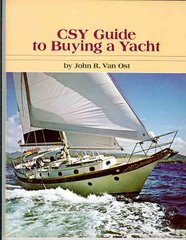
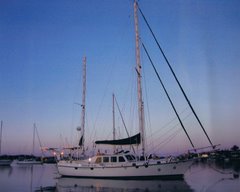
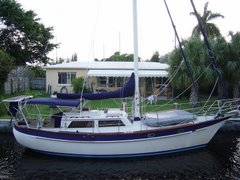
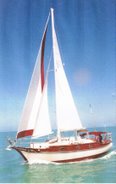
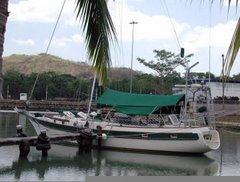
1 comment:
Thanks Mike. What was the name of your PH? Do you have any history on it? Owners? Mods? Travels?
As far as I know, there were no wiring or other schematics on CSY's in general, that us owners have been able to procure. That is especially true of the Pilot House models.
The Walk Over 44's, numbered near 400 built. The Walk Through 44, only 41. The Pilot Hose, only 22. That said, you see the rarity of the PH model, as well as they were marketed as the Queen of the fleet, with many options available.
I personally looked at 6 used CSY Pilothouses on the market, in the late 80's and early 90's before I chose mine. All were somewhat different in 'systems', layout and other aspects of interior. Exterior options were not extensive, but inside the customer had many options. The ones I was lucky enough to see, or be aboard from those years until now, appear as semi-custom productions.
Therefore, you will have to take your time to chase wiring to make your own sketches of wiring runs etc. Also, keep in mind, that over 30 years, equipment must have been added and changes made by past owners and their hired installers.
The Hull ID. # should appear on the upper corner of the stern/right side....to the right of the stern boarding ladder. It will be something like mine-
TXY020278
This stands for CSY, Hull #2, Feb. '78
Post a Comment